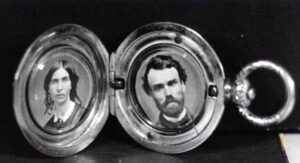This fourth installment in our series about the Kelley family features its matriarch, Eliza.

Two tiny images in a delicate locket that belonged to Eliza Owen Kelley. Eliza is pictured on the left and would have been about 30 years old. On the right is her husband William Henry Kelley, 34 years old. We presume these photographs were taken shortly after their marriage in 1855. The gold locket is an inch in diameter, with their portraits about the size of dimes. The gold case is engraved with intricate designs. (Locket belongs to the estate of Margaret Kelley Campbell).
Elizabeth Lee Owen was the daughter of Arthur Owen, a Welshman, and Mary Jardine from Scotland. Born in Cardigan, on Prince Edward Island, April 8th, 1825, she lived in Charlottetown until her marriage to William Henry Kelley in 1855, after which the couple made the long trip from the east coast of Canada to California.
It is presumed the newlyweds sailed by schooner to Colon and then across the Isthmus of Panama, but escaped the hardships suffered by William when he came west in 1850, for the railroad across the Isthmus had been completed by the time the Kelleys made their crossing. Undoubtedly any household goods Mrs. Kelley wanted to bring with her from Charlottetown were shipped around South America’s Cape Horn, as was the custom in those early years.
Mendocino in 1855 was a raw lumber town with few families, and little culture or living comforts. One wonders if William told Eliza about the hardships she would endure. We do know that she loved Mendocino and called it the most beautiful place on earth.
The Kelleys, wed in June, arrived in Mendocino in August 1855, and moved into his newly acquired house (known now as the Kasten-Heeser House). It was there that their first child, Daisy, was born in 1859. Soon after, they began building the family home down the street that still stands today.
It would be fair to call the structure that the Kelley House Museum occupies the Eliza Kelley House. While William had his store where he could hold forth with his friends and business associates, the home was the feminine domain.
Like most women of her time, Eliza’s activities and accomplishments were centered on family and the home. Here she bore and raised four children, cared for sick ones, directed the domestic help, and managed the myriad chores that life on the frontier required.
But Eliza can also be counted as one of the founders of Mendocino, contributing to its growth outside the typical feminine sphere. While others addressed the material demands for goods and services with commercial establishments, she felt the need in the community for the spiritual sustenance a church could provide. And she did something about it.
Eliza was a member of a small group that gathered for prayer and to receive the ministerial services of itinerant preachers. This group decided it was time to build a non-denominational Protestant church, and on March 2, 1862, a church bell rang out from the steeple of the first church in Mendocino.
Their building, located on Lansing Street in what is now Good Life Bakery, was a vital community resource. As the congregation grew, a larger edifice, the Mendocino Presbyterian Church, was built in 1868 down on Main Street. It was, and still is, a hub of social as well as religious activities – a worthy legacy for all that participated in its founding. Yet, Eliza wasn’t through with church-making.
It took thirty-two years, but in 1894 she at last realized her greatest ambition – the construction of a church where the small body of Baptists in Mendocino could have a place of worship. Financed completely by her family and erected on Kelley property, Eliza built the beautiful little red church (now Corners of the Mouth) that still stands on Ukiah Street for her Baptist congregation. They occupied it until about 1935, and in her honor, they placed an arched sign over the door that read, “The Kelley Memorial Baptist Church.”
Here she played the organ for the growing flock of Baptists (there were forty-two by 1910), sometimes took to the pulpit to preach, and made sure that her brothers and sisters in Christ had all they needed, including special Christmas activities that included joyful singing, beautifully decorated trees, and gifts for all.
When she died, in 1914 at the age of 89, the Mendocino Beacon printed a two-column sketch of her life. The words “thoughtful and generous” and “deeply religious” were used to describe her character. After the funeral, which took place in her home, “kind hands bore all that was mortal to her last resting place in the old cemetery on the hill and there, among those she had loved and beside the husband who had pre-deceased her by some nineteen years, she lies, while the shimmering stars look down and the waves are sounding a ceaseless requiem.”
Come visit Eliza’s house, located at 45007 Albion Street in Mendocino. Open 11am to 3 pm Thursdays through Sundays. More information can be found at our website KelleyHouseMuseum.org. or contact info@kelleyhousemuseum.org.